- Solo Personal Project
- Working on in my freetime durring 2022
- Boardgame built in Physical and Digital (tabletop sim)
- Photoshop
- Board Game Simulator
- Game Crafter (publishing site)
Tools:
Chaos Manor is a board game about escaping from a haunted manor. 2-4 Players compete to earn keys and find the exit, first one out is the winner. Every round the manor itself twists, contorts, and changes around them. They can't trust the paths they take will stay the same as they wander the halls but still they can forge new ones in order to find their way out. Players would be able to discover, break, move, and rotate roo tiles in order to make paths through the maze-like manor. Searching rooms to find items to help them on their journey. However, at the start of each players turn the Manor itself fights back, changing on its own.
This project was just to ease my love of boardgames, it was a fun personal project that let me do design work and some arts and crafts (initially). It grew from there and I ended up doing multiple playtests, 3 physical iterations, and 3 digital iterations until I alnded on my 'final' (for now) version. All fo these iterations were mixed betwene each other, going from cardboard v1 to cardboard v2 to digital for a few iterations, before getting the last version printed from gamecrafter.
Digital iterations were done using the game Tabletop Simulator, as it provided a ncie toolset for quickly importing and ease of tweaking gam components. At this point in time I had done a few iterations already and had resolved some early flow issues and the tuning was about deck balance (abilities and frequency of cards), as well as exploring friction points players had. FOr instance, while the items provided in the search mechanic were very powerful, getting them was not entirely reliable. So I modified rules surrounding how players could interact with the world, and added a "blockade" of sorts to cut off paths. Witht his players could make plans towards their goal, or defeinding against other players, without needing any cards todo it. The cards still lent players the majority fo power and options but there was always another avenue available to them.
Designing the variety of items was the most fun. Every item was powerful but situational for the most part, and the abundance meant players were not instant winners becuase they had a card- so did everyone else. They gave some dynamics to encounters between players that egged on competition. Things like being able to steal a card and anothe rplayer being able to block it. Everyone had buitl aplan for themselves, and when it was dashed by someones elses planning things were tense but exciting and fun. Even when things went awry you could try to recover. As the name suggests, the manor moving on its own added a dash of Chaos. It made things not go to plan, or created opportunities players themselves didnt expect. These reveals kept things lively up untilt he last minutes of the game.

Chaos Manor

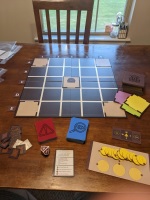
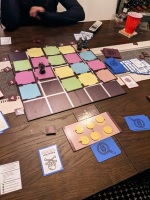
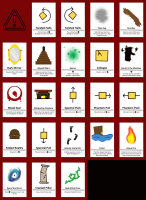
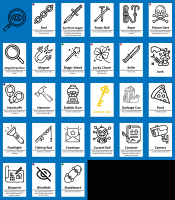
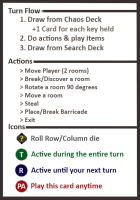
 1
1 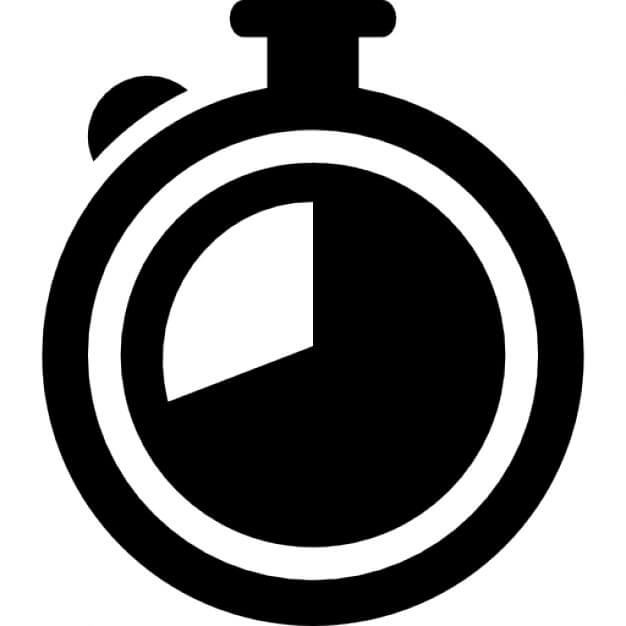 2022
2022 -
 Rulesheet
Rulesheet
- Solo Personal Project
- Working on in my freetime durring 2020
- Unity
- C#
- Photoshop
Tools:
The original purpose for this project was just to have this kind of game without 30 million ads. I love the gameplay style, its simple, straightforward, and great for short bursts of play. However, I couldnt stand every variant of the game having ads every 30 seconds, so I figured id just build my own. It was a fun endeavor! Goals are straight forward, maker a simple and fun game where you had to toss knives into a block without hitting en existing knife.
The main mechanic was simple, make the knife move forward, with some hitbox detection for existing knives and detection for the log. With that it was a matter of a fail state for hitting an already embeded knives with some added bounce flair and sfx. As knives and thrown and embeded the log progresses through different hit states before it breaks. Win state was if all knives were embeded, tied into a nice but snappy "complete" screen.
To add depth each level needed to scale (4 rounds) and get more difficult overall. So as you get further in there are a few varibles that increase and randomize. How fast the log spins, its pattern of spin, how many knives you need to toss in, and how many knives are already embeded. The already embeded knives were trickert han expected, because they had to be spread nicely and nto always bet clustered. At the same time I didn't want thema lways evenlys prea,d its too predictable, so I buitl out a system that gave the range from each other and variance. All the while balancing total knife numbers and placements so players could actually still complete every level.
Just throwing knives can still be a bit mindless, even when it gets intense when space is tight and you have mutiple knives left. So I added a goal, something to strive for. With a lightweight highscore system players could trakc their best and have something to achieve and grade their own skill progressing.
This game also acted as an exercise in publishing games to the google play store. I didn't know the process, and figured what better way than put a gameup. So I did.

Stump










 1
1  2020
2020 -
 Github
Github
-
 Play Store
Play Store
- 3 Person Team
- (2 Programmers & 1 Level Designer)
- 14 week Project
- C#
- Unity
- Unity Networking
- PM & Programming Lead
- Gameplay Programmer
- UI Developer
- Networking Developer
- Design
Tools:
Roles:
"A twist on the childhood classic"
My second run at a digital envisioning of the childhood game of the same name. This version took a different approach and focus from the mobile version I had worked on, as well as being built with an entirely different team. This version of The Floor is Lava focused on more cartoony and childlike visuals, abilities to provide agency, and the largest unique element is the fact it is a networked multiplayer game.
The visuals of the game were chosen from the Unity Assets store because we did not have 3D modelers, but still chosen with respect to the soft childhood concept. Thus all models are soft and cartoony, lending themselves to PG tone and supporting childhood. On top of that we aimed to keep UI elements and bits of flair to also repsect that by being colourful and entertaining. Some of the abilities have fun shader abilites that also help withoverall polish and defining certain abilites but also support another aspect of childhood that is represented in this game: Imagination.
The abilites in the game were brought on from ways of letting players recover from mistakes or attempt to define paths of their own. We have three abilities. 1. Double Jump which is simple, players can jump again midair. This is great for recovery on a gap or a bad jump. Second an "emergency platform", like throwing a pillow on the ground when you were a kid to bridge between furniture- it works the same way. Players throw an extra platform that will help them bride gaps and put in a temporary platform. Finally, low gravity, which is also helpful for bridging gaps because it lengthens the players jumps distance.
Finally, the game is fully networked for multuplayer gameplay. Players run against each other for best time through the level, being slightly combative (maybe using their support abilities to slow or hit other players off)

The Floor is Lava
 RIT
RIT  3
3  14 weeks
14 weeks -
 Github
Github
-
 Design Document
Design Document
- 9 Person Team
- (4 Artists, 5 Designers & Programmers)
- 14 week Project
- C#
- Unity
- Windows Mixed Reality Headset
- Programming Lead
- Gameplay Programmer
- VR Controls Programming
- Design
Tools:
Roles:
"A VR puzzle-stealth game"
Players must help a theif named Tiny Terry steal gems, avoid guards, and get out undetected. However, Tiny Terry isnt a very good theif so he is going to have to get a lot of help. Players will move obstacles, help terry hide in armour, and open locked doors to get terry through each floor of the castle. Players dot his by interacting with objects in each floor from a god-like overview; picking up tables and moving them or watching overhead to see the guards paths.
Our VR Game, Castle SilVR, has three levels: one tutorial, and two actual floors. Secondly, we have six different kinds of interactable objects. Movable, Sliding, Hiding, Distractions, Doors and Keys, and of course the collectible gems.

Castle Silvr
 RIT
RIT  9
9  14 weeks
14 weeks -
 Github
Github
-
 Design Document
Design Document
-
 Gameplay Video
Gameplay Video
- 5 Person Team
- 5 week Project
- C#
- Unity
- Gameplay Programmer
- User Interface
- Design
Tools:
Roles:
"May Darkness light the way"
A stealth game all about light. As a shadow-person your body can't handle the light and you not only are hurt, but lose mass in the light. Players must avoid the light, the Bright Guards, and escape with your life intact. Stick to the shadows as much as possible.
This project I worked primarily on gameplay programming for a couple of our different lights, and designed the UI for the main menu as well as HUD. I designed two kinds of lights to give variation to one of the main problems to solve in the game: moving around whilst not getting hurt by light. The first only is a search light that projects a beam, I designed it so that is essentially a moveable wall of light. The searchlight projects a beam but the light itself can be turned by the player to both move out of the players way, as well as be used to illuminate parts of the maps. The other type I created was a light that "flickers: between on and off for set time intervals. This allows players to get a feel for the space fo the map but also create holes to pass through and not be harmed, while still providing a challenge.
The main menu was simple enough, a fun logo and three buttons (Play, credits, and quit). The ingame HUD as well as responsive effects are more interesting. The HUD is simple overall but designed keenly. The HUD is a white bar across the bottom of the screen, cut into a few sections- this is the health bar. Players have the ability to emit light themselves, while this is helpful for brightening surroundings it still hurts the players, because of this health was made to be regenerative. The issue was that players would abuse this because health would always come back, and they didn't worry about going into light too often because of that same reason. To put fear back into light and wary into the players- while still allowing players to use the tools at their disposal I made health sectioned. This made it so health would regenerate up to a point (the top of each section), but if they abused their abilities of found themselves in the light they would still take a hit overall.
Another issue that I resolved surrounding health was the fact players (before we introduced a proper health bar) didn't know they were getting hurt or how hurt they were. Initially the player object was being shrunk, like how a shadow fades in light. Players didn't really notice this much, if they did it too a little. TO help resolve this I added a particle effect and a red tint to the screen when being hurt. The red tint is common in games, red says hurt. So they understood very quickly what was happening. The particle effect helped this even more because it gave the effect of losing mass as light particles came off the player object.

LUX
 RIT
RIT  5
5  5 weeks
5 weeks -
 Github
Github
-
 Write-Up
Write-Up
-
 Gameplay Video
Gameplay Video
- 8 Person team
- (3 Art, 5 Designers & Programmers)
- 8 Week Project
- Unity
- C#
- Photoshop
- Level Design
- UI Programming and Design
- Base Architecture Programming
- Sound Programming and Implementation
Tools:
Roles:
"A competitive, pirate based, platformer-racer."
Players alternate between Pirate and Parrot every 30 seconds. As the pirate the players goal is to avoclass traps, and items dropped on them by the opposing player as they platform through the course and try to reach the Treasure first. As the parrot, players attempt to slow down the other player by activating traps on the map and dropping utility items like bear traps and heat seeking coconuts.
My work on this project was in a few different points. Firstly, Level design and world building. I designed a level for the game that featured 2 core paths that would increasingly go upward and cross cross. ON top of that there were minor paths here and there to create shortcuts for the bold, or to avoid the hindered paths ahead. (Hindered by the actions of the other player). While this level was not fleshed out by the end of our available time, I did also do all the worldbuilding of the level that was finalized. I used the various props we had to change the lanes of platforms into a more vivid game world. I am a firm believer that the minor details of something help bring out the best in it- and I feel these details brought out the life in the game world.
Secondly, I worked on the UI, specifically the HUD and minor functionality tweaks for the Pause menu. The HUD has a few key features, which are all reiterated in another way in order to reinforce the same information more naturally, and/or expand upon it. These parts are the distance to goal tracker, active trap indicator, and timer for next role switch. Players need to know where the other players racer is at a given time in order to put traps near them, and generally keep track of who is in the lead of how much distance is between them. For this reason the distance to goal tracker exists, it shows the players location on a scale of a point from start to finish. This is reinforced by a glowing beam a players parrot can call forth to get that same information in the actual levels space; this expands on the distance bar on the HUD because it gives the 3D location not just distance traveled between start and end in a 2D fashion. Next, the active trap indicator shows which trap a players parrot has enabled (ie Bear Trap, Lantern, or Coconut), a simple icon shows which one is active and a radial overlay shows the cooldown time until a player can sue their ability again. This is reiterated underneath the parrot itself with the physical model that will be dropped. Finally, the phase timer is shown in the exact middle of the screen, it allows players know how much time they have to make a daring play for a further platform or set a trap for the other player. Whats really important for that is the few seconds leading up to the switch, so on the HUD bar itself during the last 5 seconds the timer goes red to pronounce this. Players had an issue with the shock of the phase change, even with the timer. To resolve this I created a semi-transparent overlay for the players screens that also showed the last 5 second countdown in a large font. Something very noticable. This seemed to work wonderfully, as players no longer were shocked by the change but expected it, and supported the tension of those last few moments in a phase.

BlackFeather
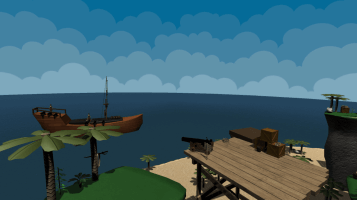
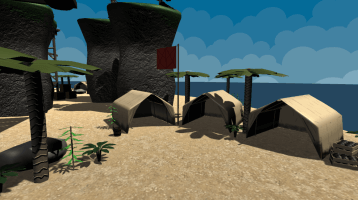
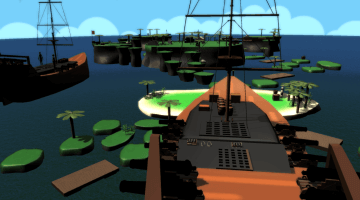
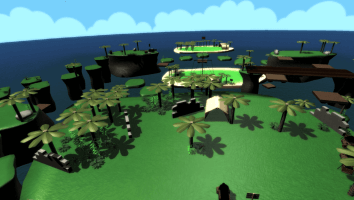
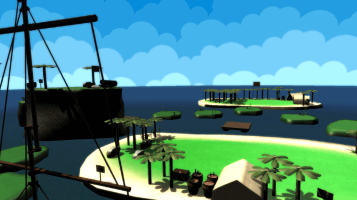
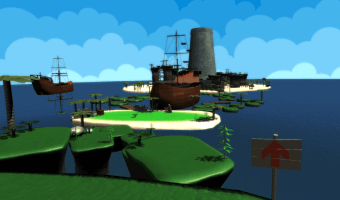
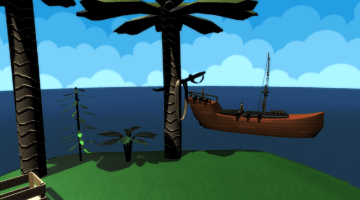
 RIT
RIT  8
8  8 weeks
8 weeks -
 Github
Github
-
 Gameplay Video
Gameplay Video
- 3 Person Team
- 1 Week Project
- Visual Studio
- C#
- Betting Round 1 Behavior Programming
- Betting Round 2 Behavior Programming
- Other Player Evaluation Programming
Tools:
Roles:
"A poker playing Artifical Intelegence."
An AI that responds to the actions of the other player, and uses it to estimate their hand strength.
Initally it assumes the other player has nothing of value, but as they bet and discard cards, the AI will re-eveluate their estimated hand strength and respond accordingly. It also takes into account its own hand strength when it takes action.
Note: We only created the AI, we did not program the game of poker it plays.

Poker AI
 RIT
RIT  3
3  1 week
1 week -
 Github
Github
- 6 Person Team
- 48 Hour Project
- Game Jam Project
- C#
- Unity
- Gameplay Programming
- Game Design
- Level Deisgn
Tools:
Roles:
"You can't see them, but they can see you."
Silver Echo is a game made within 48 hours for Global Game Jam 2017. The theme was waves. For our game we created a stealth game where you cannot see the enemies patroling the level, unless they are caught by an echo pulse from the player. Players must avoid the vision cones of the enemies whilst gathering keycards to exit the level. The game seemed to achieve a level of intensity that players really enjoyed; players would be on their toes the entire time and had their heart racing when they attempted to run from someone who noticed them.

Silver Echo
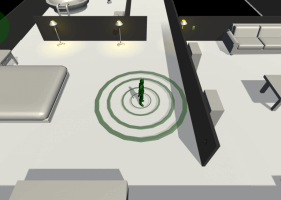
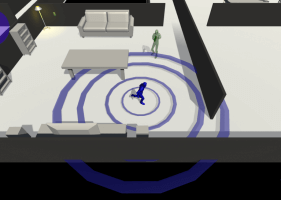
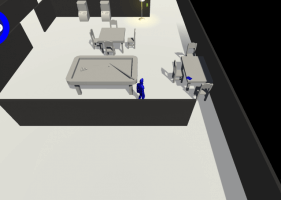
 RIT
RIT  6
6  48 Hours
48 Hours -
 Github
Github
-
 Global Game Jam
Global Game Jam
-
 Download
Download
-
 Trailer
Trailer
- 4 Person Team
- 5 week Project
- C#
- Unity
- Photoshop
- Maya
- Gameplay Programming
- Controls Programming
- Game Design
- Level Design
Tools:
Roles:
"How hard is it to cook when you can't control one of your hands?"
For College Cooking we aimed to create a unique couch co-op experience. So, we made a cooking game where two people each control one hand and have to work together to make a multi-step meal. On top of that we wanted to add a layer of difficulty, which went into the controls. Our control scheme was designed to be slightly difficult whilst still useable- you just needed to acclimate a bit. Very "Surgeon Simulator". While this sounds counter-intuative for games, putting a barrier between their experience, but we felt it acted as more of a challenge for the players- and when you dont have enemies you need someelse to challenge players.
Unfortunatley, due to our time constraints on this project we only ever got one recipe done. Simply cook an egg.
The biggest challenge we faced with this game was most definitely the control scheme. We had to find a way to translate the complex 3D movements of a hand onto an xbox 360 controller.

College Cooking
 RIT
RIT  4
4  5 weeks
5 weeks -
 Github
Github
- 4 Person Team
- 5 week Project
- Board Game
- CardBoard
- Hot Glue
- Determination
- Game Design
- Mechanic Design
- Balancing
- Prototype Building
Tools:
Roles:
"You fell into a cave with your friends. It is too dark to see. You can hear a monster. You need to escape."
The Path Untouched is a unique board game experience, designed to be played without seeing. Up to 4 players must wear blindfolds, and use their sense of touch to feel their way through a maze and communcating what they are doing to each other. Each player also has an ability to use that will give them not only a role in their adventure, but tools to help them navigate the maze. The players must work together to not only get out of the maze, but also avoid traps and a monster that is chasing them.
The game was built with replayability in mind, that being said the board had a modular design- a set of tiles and velcro to allow the Dungeon Master to create whatever adventure they would like.

The Path Untouched
 RIT
RIT  4
4  5 weeks
5 weeks -
 Booklet
Booklet
- 5 Person Team
- 8 week Project
- Board Game
- Game Design
- Mechanic Design
- Balancing
- Prototype Building
Roles:
"Better dealing lead than lying Dead"
Fast paced, twitch card game inspired by Spaghetti Western movies. Designed from start to finish by a team of 5, we crafted a fun, exciting, and fast paced class based card game. Players must drop cards on mats within a small timeframe to shoot at other players, and react to things dropped on their own mats in the same timeframe. Each classes deck of cards gives them advantages and disadvantages relative to each other, allowing players to chose a class that fits their own playstyle best whilst still allowiing them to be flexible according to the current events of the game.

Gun Fighters
 RIT
RIT  5
5  8 weeks
8 weeks -
 Rulesheet
Rulesheet
-
 Gamecrafter Package
Gamecrafter Package
